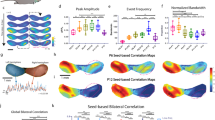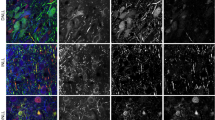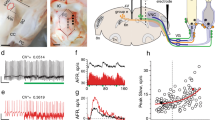Abstract
RECENT anatomical evidence obtained in the cat indicates that two sets of nerve fibres actually contribute to the efferent bundle (Kasmussen) which forms the anastomosis of Oort between vestibular and cochlear nerves and which travels centrifugally towards the organ of Corti in the inner ear. Approximately three-quarters of the fibres are crossed and originate from small neurones adjacent to the accessory nucleus of the oliva superior on the opposite side of the brain-stem1. The remaining quarter of these efferent axons originates from neurones located on the dorsal aspect of the principal S-shaped nucleus of the oliva superior on the same side2. Many data have been collected on the function of the crossed component3–6, which can be activated at its decussation under the floor of the fourth ventricle (Fig. 1, F) and the inhibitory effect of which on auditory input is quite powerful, ranging up to a −25 db equivalent attenuation of sound energy6. A special feature of this pure inhibitory pathway is that the (long) axons available for stimulation synapse directly on to afferent auditory terminals and hair cells with no interposed interneurone2,7. The uncrossed efferent fibres also establish direct connexions with the inner ear structures7, but their functional properties are still unknown.
This is a preview of subscription content, access via your institution
Access options
Subscribe to this journal
Receive 51 print issues and online access
$199.00 per year
only $3.90 per issue
Buy this article
- Purchase on Springer Link
- Instant access to full article PDF
Prices may be subject to local taxes which are calculated during checkout
Similar content being viewed by others
References
Rasmussen, G. L., in Neural Mechanisms of the Auditory and Vestibular Systems, Chap. 8, 105 (Ch. Thomas Pub., Springfield, 1960).
Rasmussen, G. L., J. Comp. Neurol., 84, 141 (1946).
Galambos, R., J. Neurophysiol., 19, 424 (1956).
Desmedt, J. E., and Monaco, P., Nature, 192, 1263 (1961); Proc. First Intern. Pharmacol. Meeting, 8, 183 (Pergamon Press, Oxford, 1962).
Fex, J., Acta Physiol. Scand., Supp. 189, 55, 1 (1962).
Desmedt, J. E., J. Acoust. Soc. Amer., 34, 1478 (1962).
Smith, C. A., and Rasmussen, G. L., Ann. Otol., etc., St. Louis, 72, 489 (1963).
Schuknecht, H. F., Churchill, J. A., and Doran, R., Amer. Med. Assoc, Arch. Otolaryngol., 69, 549 (1959); Vinnikov, J. A., and Titova, L. K., Z. mikr.-anat. Forsch., 69, 42 (1962).
Author information
Authors and Affiliations
Rights and permissions
About this article
Cite this article
DESMEDT, J., LAGRUTTA, V. Function of the Uncrossed Efferent Olivo-cochlear Fibres in the Cat. Nature 200, 472–474 (1963). https://doi.org/10.1038/200472b0
Issue Date:
DOI: https://doi.org/10.1038/200472b0
This article is cited by
-
Extracellular nucleotide signaling in the inner ear
Molecular Neurobiology (1998)
-
Anatomisch-pathologische Aspekte der Elektrostimulation des ertaubten Innenohres
Archives of Oto-Rhino-Laryngology (1979)
-
Absence of a function for the crossed olivocochlear bundle under physiological conditions
Archiv f�r klinische und experimentelle Ohren- Nasen- und Kehlkopfheilkunde (1969)
-
Postsynaptische, auditorische, gekreuzte, efferente hemmung im nucleus cochlearis ventralis und ihre Blockade durch Strychninnitrat (Meerschweinchen)
Archiv f�r klinische und experimentelle Ohren- Nasen- und Kehlkopfheilkunde (1968)
-
Neural Inhibition in a Bird : Effect of Strychnine and Picrotoxin
Nature (1963)
Comments
By submitting a comment you agree to abide by our Terms and Community Guidelines. If you find something abusive or that does not comply with our terms or guidelines please flag it as inappropriate.



